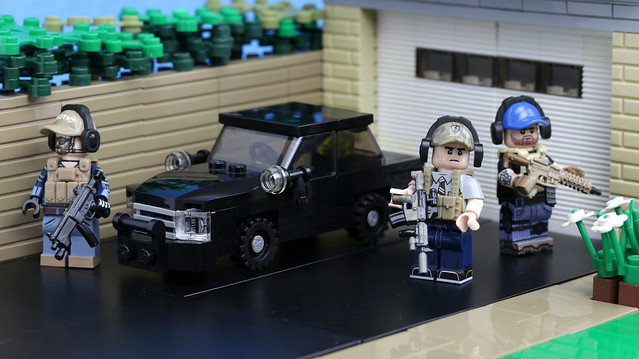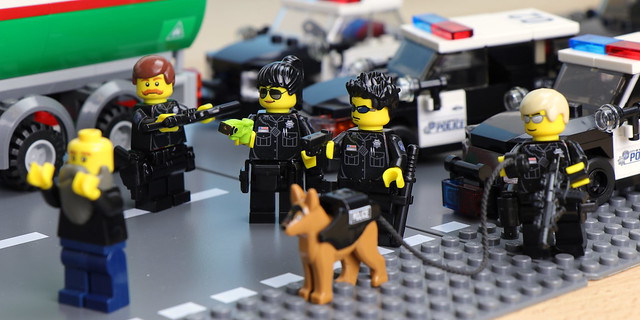- Joined
- Jan 17, 2010
- Messages
- 4,532
- Reaction score
- 5,495
By Joanna Slater
October 4, 2023 at 4:00 p.m. EDT
AGINAW TOWNSHIP, Mich. — Snow crunching under their feet, breaths coming quickly, the officers grabbed their duty rifles and ran toward Nouvel Catholic Central High School.
The code had gone out just two minutes earlier on Feb. 7: active shooting in progress.
They didn’t hesitate. When they found that the double doors next to the parking lot were locked, one officer rammed them with his cruiser and smashed them open. Another stepped over the shattered glass and into a hallway lined with lockers. “Move, let’s move, let’s move!” he yelled, in moments captured on body camera.

Police officers used a cruiser to force their way into a school in Saginaw Township after what turned out to be hoax call. (Saginaw Township Police Department)
Lt. James Rich was one of the officers at the scene. He remembers the rush of adrenaline and the strange silence inside the school. It felt like a puzzle whose pieces didn’t fit.
Officers checked every room in the building. They found nothing except terrified children and teachers.
The 911 call that led police there had been a hoax.
It got stranger. At least eight other schools across Michigan were targeted with similar hoax calls that morning.
For weeks, Rich would wake up in the middle of the night, replaying the incident in his mind. His colleague had a term for what happened: terror without a body count.
Even months later, one question gnawed at him. Who was behind the calls?
That same question has troubled police departments across the country.
Over the past year, more than 500 schools in the United States have been subjected to a coordinated campaign of fear that exploits the all-too-real American danger of school shootings, according to a review of media reports and dozens of public records requests. The Washington Post examined police reports, emergency call recordings, body-camera footage or call logs in connection with incidents in 24 states.

The calls are being investigated by the FBI and have generated an aggressive response by local law enforcement — particularly after officers in Uvalde, Tex., came under criticism for waiting more than an hour to confront the gunman during the May 2022 elementary school massacre.
In state after state, heavily armed officers have entered schools prepared for the worst. Students have hidden in toilets, closets, nurse’s offices. They’ve barricaded doors with desks and refrigerators. Medical helicopters have been placed on standby while trauma centers have paused surgeries, anticipating possible victims. Terrified parents have converged on schools, not knowing if their children are safe.
The wave of school shooting hoaxes is without precedent, education safety experts and law enforcement officials say. It’s part of a larger phenomenon known as “swatting,” where callers report nonexistent crimes with the goal of triggering a police response — preferably by SWAT teams — at the homes of enemies or celebrities.

The shooting hoax calls often come in waves, with multiple schools in a state targeted on the same day, and most are “remarkably similar,” said Drew Evans, the superintendent of the Minnesota Bureau of Criminal Apprehension. More than 20 schools in the state were targeted in two separate incidents, one in September of last year and another this February.
“This is a really serious crime,” Evans said. “It places everybody in a situation of potential danger to have police officers rushing into a school.”
Many of the calls have followed a distinct pattern, according to police reports and recordings reviewed by The Post.
A male voice says that he is inside a school and that multiple students are shot. Many times, he claims to be a teacher. He says he is in a particular classroom or a bathroom, and tells the police to hurry.
He speaks with a heavy accent, police reports note. The calls first come in on non-emergency lines and are not recordings: The speaker interacts with dispatchers and responds to their questions.
When local authorities tried to trace the fake school shooting calls, they quickly ran into obstacles. Police reports show that the caller used free internet-calling services that allow anyone with an email address to make calls that appear to be coming from a U.S. number.
In incidents in at least 12 states, The Post found, the numbers were provided by TextNow, a Canadian company that offers free calls using voice over internet protocol, or VoIP.

TextNow says it works proactively to prevent bad actors from using its service while also keeping it free and accessible. The company “does not condone the use of our platform for harassment, fraud or other illegal activity that jeopardizes public safety,” said Derek Ting, TextNow’s co-founder, in a blog post in August. “However, when serving millions of people of various backgrounds and needs, you cannot solve every challenge with the biggest hammer you can find.”

A familiar voice
Three months before the hoax calls in Michigan, something strikingly similar unfolded in northern Louisiana. A male voice described by police as having a “foreign accent” reported an active shooting in progress at a high school in Bossier Parish, near Shreveport. Patrol officers raced to the scene but found no threat.
The detective who took the case, Capt. Shannon Mack, relished the chance to investigate the call. Her probe would unravel fresh details of the shooting hoax mystery, turning up clues and dead ends.

Lt. James Rich of the Saginaw Township Police Department in July. (Emily Elconin for The Washington Post )
A 15-year veteran of the sheriff’s department, Mack has developed a self-taught expertise in cases involving internet-based phone services. “That’s my niche,” said Mack, 49. She likes that it’s technical and sometimes tedious. She especially loves the feeling of “tracking someone who thinks they can’t be tracked.”
At first, people used such services to harass or intimidate a spouse or enemy, believing they couldn’t be identified, Mack said. Then the numbers began to show up in cold-calling scams to swindle people. It’s only in the last few years that Mack has started to see the VoIP numbers used for swatting.
“Nine times out of 10, it’s a TextNow number,” Mack said.

After Bossier Parish received the school shooting hoax call in November, Mack sought several search warrants. She started with TextNow, asking for all the information the company had about two numbers linked to the incident: call logs, internet protocol addresses, account setup data. Then she moved on to Google and Apple, asking for everything they had on the email addresses that created the TextNow accounts.
The result was a trove of data that offered a minute-by-minute window into the activity of the perpetrator — or perpetrators. The logs revealed hundreds of calls over a roughly two-week period, many to police departments, schools and even restaurants. The caller mostly dialed numbers in the United States, but there were also a few dozen calls made to Australia and Canada.
One TextNow number was linked to school shooting hoaxes in at least six states: Alaska on Nov. 2; California and Texas on Nov. 4; Maine on Nov. 15; Ohio and Louisiana on Nov. 16.
October 4, 2023 at 4:00 p.m. EDT
AGINAW TOWNSHIP, Mich. — Snow crunching under their feet, breaths coming quickly, the officers grabbed their duty rifles and ran toward Nouvel Catholic Central High School.
The code had gone out just two minutes earlier on Feb. 7: active shooting in progress.
They didn’t hesitate. When they found that the double doors next to the parking lot were locked, one officer rammed them with his cruiser and smashed them open. Another stepped over the shattered glass and into a hallway lined with lockers. “Move, let’s move, let’s move!” he yelled, in moments captured on body camera.

Police officers used a cruiser to force their way into a school in Saginaw Township after what turned out to be hoax call. (Saginaw Township Police Department)
Lt. James Rich was one of the officers at the scene. He remembers the rush of adrenaline and the strange silence inside the school. It felt like a puzzle whose pieces didn’t fit.
Officers checked every room in the building. They found nothing except terrified children and teachers.
The 911 call that led police there had been a hoax.
It got stranger. At least eight other schools across Michigan were targeted with similar hoax calls that morning.
For weeks, Rich would wake up in the middle of the night, replaying the incident in his mind. His colleague had a term for what happened: terror without a body count.
Even months later, one question gnawed at him. Who was behind the calls?
That same question has troubled police departments across the country.
Over the past year, more than 500 schools in the United States have been subjected to a coordinated campaign of fear that exploits the all-too-real American danger of school shootings, according to a review of media reports and dozens of public records requests. The Washington Post examined police reports, emergency call recordings, body-camera footage or call logs in connection with incidents in 24 states.

The calls are being investigated by the FBI and have generated an aggressive response by local law enforcement — particularly after officers in Uvalde, Tex., came under criticism for waiting more than an hour to confront the gunman during the May 2022 elementary school massacre.
In state after state, heavily armed officers have entered schools prepared for the worst. Students have hidden in toilets, closets, nurse’s offices. They’ve barricaded doors with desks and refrigerators. Medical helicopters have been placed on standby while trauma centers have paused surgeries, anticipating possible victims. Terrified parents have converged on schools, not knowing if their children are safe.
The wave of school shooting hoaxes is without precedent, education safety experts and law enforcement officials say. It’s part of a larger phenomenon known as “swatting,” where callers report nonexistent crimes with the goal of triggering a police response — preferably by SWAT teams — at the homes of enemies or celebrities.

The shooting hoax calls often come in waves, with multiple schools in a state targeted on the same day, and most are “remarkably similar,” said Drew Evans, the superintendent of the Minnesota Bureau of Criminal Apprehension. More than 20 schools in the state were targeted in two separate incidents, one in September of last year and another this February.
“This is a really serious crime,” Evans said. “It places everybody in a situation of potential danger to have police officers rushing into a school.”
Many of the calls have followed a distinct pattern, according to police reports and recordings reviewed by The Post.
A male voice says that he is inside a school and that multiple students are shot. Many times, he claims to be a teacher. He says he is in a particular classroom or a bathroom, and tells the police to hurry.
He speaks with a heavy accent, police reports note. The calls first come in on non-emergency lines and are not recordings: The speaker interacts with dispatchers and responds to their questions.
When local authorities tried to trace the fake school shooting calls, they quickly ran into obstacles. Police reports show that the caller used free internet-calling services that allow anyone with an email address to make calls that appear to be coming from a U.S. number.
In incidents in at least 12 states, The Post found, the numbers were provided by TextNow, a Canadian company that offers free calls using voice over internet protocol, or VoIP.

TextNow says it works proactively to prevent bad actors from using its service while also keeping it free and accessible. The company “does not condone the use of our platform for harassment, fraud or other illegal activity that jeopardizes public safety,” said Derek Ting, TextNow’s co-founder, in a blog post in August. “However, when serving millions of people of various backgrounds and needs, you cannot solve every challenge with the biggest hammer you can find.”

A familiar voice
Three months before the hoax calls in Michigan, something strikingly similar unfolded in northern Louisiana. A male voice described by police as having a “foreign accent” reported an active shooting in progress at a high school in Bossier Parish, near Shreveport. Patrol officers raced to the scene but found no threat.
The detective who took the case, Capt. Shannon Mack, relished the chance to investigate the call. Her probe would unravel fresh details of the shooting hoax mystery, turning up clues and dead ends.

Lt. James Rich of the Saginaw Township Police Department in July. (Emily Elconin for The Washington Post )
A 15-year veteran of the sheriff’s department, Mack has developed a self-taught expertise in cases involving internet-based phone services. “That’s my niche,” said Mack, 49. She likes that it’s technical and sometimes tedious. She especially loves the feeling of “tracking someone who thinks they can’t be tracked.”
At first, people used such services to harass or intimidate a spouse or enemy, believing they couldn’t be identified, Mack said. Then the numbers began to show up in cold-calling scams to swindle people. It’s only in the last few years that Mack has started to see the VoIP numbers used for swatting.
“Nine times out of 10, it’s a TextNow number,” Mack said.

After Bossier Parish received the school shooting hoax call in November, Mack sought several search warrants. She started with TextNow, asking for all the information the company had about two numbers linked to the incident: call logs, internet protocol addresses, account setup data. Then she moved on to Google and Apple, asking for everything they had on the email addresses that created the TextNow accounts.
The result was a trove of data that offered a minute-by-minute window into the activity of the perpetrator — or perpetrators. The logs revealed hundreds of calls over a roughly two-week period, many to police departments, schools and even restaurants. The caller mostly dialed numbers in the United States, but there were also a few dozen calls made to Australia and Canada.
One TextNow number was linked to school shooting hoaxes in at least six states: Alaska on Nov. 2; California and Texas on Nov. 4; Maine on Nov. 15; Ohio and Louisiana on Nov. 16.











